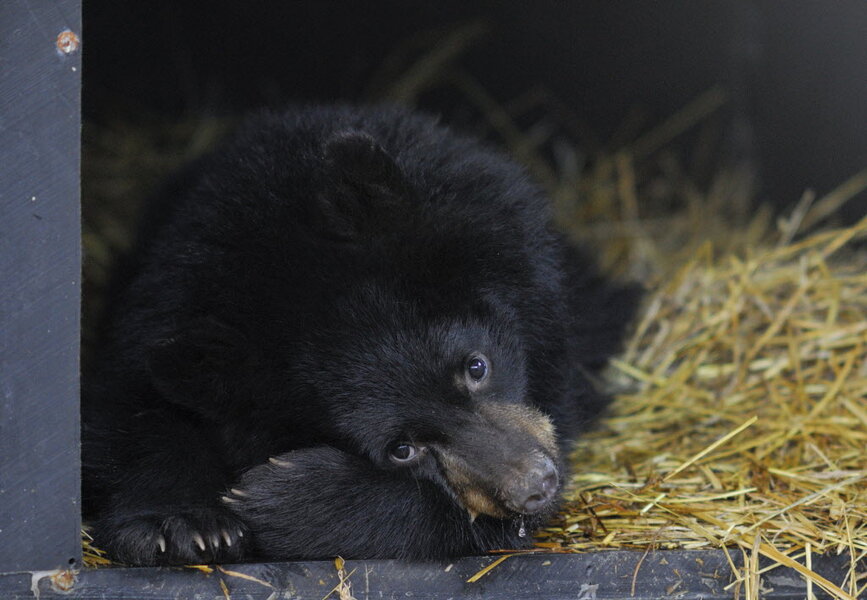What hibernating bears can tell us about space travel
Loading...
Scientists have taken an unprecedented look at the biological changes bears undergo when they bed down for winter, and the results have been little short of stunning, researchers say.
From an unexpectedly dramatic slowdown in the chemical processes that keep the bears alive to their rafter-rattling snores, ursine metabolic tricks may suggest more-effective ways of stabilizing trauma patients as they await hospital treatment, the researchers involved say.
In addition, the project's results could contribute to new approaches for helping astronauts counter the physical changes they experience during long missions in space, the scientists add.
The study, which appears in this week's issue of the journal Science, shows that during the five to seven months black bears hibernate, their heartbeats slowed to as few as nine beats per minute, often with pauses that last up to 20 seconds. The chemical processes that keep them alive slow to only 25 percent of their summertime, most-active levels.
Studies of other, smaller hibernating creatures, such as arctic ground squirrels, suggested that a hibernating animal's metabolism rate falls by 50 percent for every 10-degree drop in body temperature. But the bears' body temperatures dropped only 5 or 6 degrees, while their metabolism plunged 75 percent. And as other studies on hibernating bears had shown, the animals did not lose significant amounts of bone or muscle mass for their seven months of inactivity.
It's the bears' ability to radically slow their life-support system while maintaining muscle and bone mass that make the results so intriguing for human purposes, suggests Brian Barnes, a scientist at the Institute of Arctic Biology at the University of Alaska and the senior scientist on the project.
"Somehow they've tricked their tissues – their bones and muscle – into thinking that they are still doing work," he says. By discovering the biochemical signals that perform that trick, he continues, it might be possible to chemically reproduce the same feat in humans.
The research involved observations of five bears over three years. The Alaska Department of Fish and Game provided the bears after capturing them as "nuisance animals" – predators wandering too close to human populations for human comfort.
The research team, led by Øivind Tøien, another scientist at the Institute of Arctic Biology, set up pens in a remote area near the Institute and provided large boxes with straw padding for the bears to use as dens.
A surgeon implanted a device in each bear to monitor body temperature, heartbeat, and muscle movement. The hibernation boxes were equipped with infrared video cameras, a pump to provide fresh air, and instruments to measure oxygen and carbon dioxide levels in the air – measures of metabolism.
The measurements were relayed via radio to a nearby trailer, where the information was recorded and from which Dr. Tøien could monitor his charges during daily visits to the site.
The team found that during hibernation, the bears' body temperatures dropped, but not nearly as low as smaller creatures, like the Arctic ground squirrel, whose body fluids freeze for brief periods.
The bears' lowered temperatures went through irregular cycles, the scientists found. Every day or two, the temperature would reach its lowest point, then recover, then fall again. The temperature increases coincided with bouts of shivering – as though the bears had internal thermostats that triggered a shiver-induced warm-up, once the body temperature fell to a critical threshold.
No other hibernating mammals have been observed showing such large cycles without waking up, the researchers say.
In addition, the bears breathed only once or twice each minute – in deep, rumbling snores separated by long periods of silence.
The bears weren't completely inactive; they got up once every day or two to change positions.
The surprises continued after hibernation ended. With many hibernating mammals, body processes return to normal almost as soon as hibernation ends.
The bears' metabolism rates took two to three weeks to return to normal, though their body temperatures recovered much more quickly.
Once the experiments ended, the researchers euthanized the bears so the team could begin the detailed analyses to help uncover the biochemical triggers for the changes the team had observed.
One final surprise: Though the scientists hadn't planned to study the effects of disturbing a hibernating bear – something hikers sheltering in a cave often wonder about – New Year's fireworks at the university provided an unexpected test.
"It woke him up," Dr. Barnes recalls. "He lifted his head, looked around, and went right back to sleep. So black bears, at least, are very resistant to disturbance" when they bed down for a long winter's nap.





